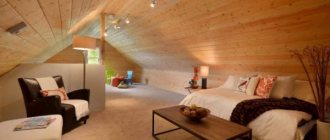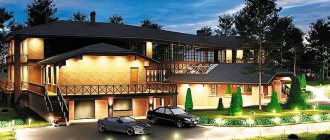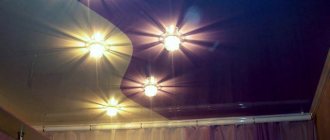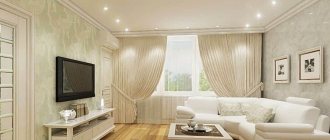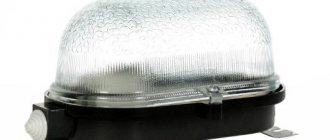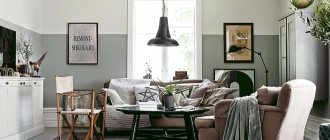Proper lighting at home creates beauty, convenience and coziness. Most people think that this requires a chandelier. But it is not always appropriate, especially in cramped spaces like a long hallway or a Khrushchev-era hall. In order not to clutter up the space and make it lighter, they use lamps and other devices that traditionally perform an auxiliary function. In this article we will look at the best options and suitable devices for different types of finishing.
How to organize lighting?
Before choosing lamps, you need to decide on their functional purpose.
- To decorate a living room, general lighting is usually used (or central, when the lamps are located under the ceiling), directional (or task, when the light falls on a certain surface), and decorative (designed to create the desired atmosphere).
- The convenience of using light depends on the location of the switches. Their installation should be considered at the stage of creating a design project. The optimal options for placing switches are: the space near the door, the walls near the sofa for relaxation, as well as the work area.
- It is worth remembering that one chandelier in the living room is not enough. Overhead lighting does not provide much light, so there must be at least two sources.
- Light helps to visually enlarge a small living room with a low ceiling. One such way is to use floor lamps. It is also recommended to install LED lighting around the perimeter of the ceiling to visually deepen it.
Additional lighting devices
They are installed in a corner for reading, handicrafts, when light accents and highlighting of bright interior items are needed - for example, paintings, stucco moldings, decorations, etc. These are:
- Wall lights . They can be built-in or overhead (sconces), in design - armature, wall-mounted (used in a narrow space, as a backlight for pictures), stationary, adjustable, with a reflected and directed beam. When the main lighting is turned off, sconces create a cozy atmosphere; they are installed near the reading chair to emphasize the interesting texture and stucco molding. Wall sconces in the work area replace a table lamp. When placing sconces, you need to make sure that they do not interfere with the passage.
- Floor lamps . This is the common name for a floor lamp. Typically, such a device has a leg (straight, curved, or even adjustable in height or offset). Thanks to the lampshade and diffuser, the device produces dim, diffused light. The beam is directed up or down, in both directions. But the cap is an optional attribute; models are produced without this detail. Floor lamps can be stationary or portable, with one or more lamps.
- Bottom lighting . Floor-recessed lamps are still rarely used, although they look very impressive, especially in recreation rooms. They are usually built into podiums - like ceiling “points”.
- Desk lamp . They are also placed on the fireplace, bedside tables, near the sofa if they are working on it, etc.
- Optical fiber . This light source is economical and, most importantly, safer than its analogues. It can be used even in damp areas. Optical fiber emits light in transverse and lateral projection. This allows you to create a variety of compositions - for example, the popular “starry sky”. The fiber is cut even when it is turned on - no current is transmitted through it. Although the material is used for the main lighting, its task is still auxiliary lighting.
What lamps are suitable for the hall?
Using different types of fixtures, you can create several types of lighting in the living room.
Spots
Individual objects (paintings, collections of objects) or certain areas can be effectively emphasized with the help of spotlights. They can be suspended, built-in or movable on a rail. Rotating lamps can be adjusted horizontally and vertically. Whether the spots will cope with the main lighting (for example, built into a suspended ceiling) or will serve as directional sources depends on their number and location.
The photo shows a living room with combined light, where the role of the main lighting is played by ceiling spots.
Chandelier
A traditional lighting option in the living room is a chandelier. When choosing it, you should take into account not only the style of the interior, but also the size of the lighting fixture, as well as the degree of light dispersion. For a small living room, a ceiling chandelier mounted close to the surface is suitable, and owners of spacious rooms and high ceilings can choose a classic pendant product on a long stand or chains.
The photo shows a loft-style living room, the low ceilings of which are illuminated by a chic chrome chandelier and LED lighting.
Sconce on the wall
Wall sconces are often located in the relaxation area - behind the sofa or the head of the bed, if the living room requires a sleeping place. They can form a pair or act as an independent light source. In a country cottage, lamps are hung on either side of the fireplace or above it. Light directed upward can visually lift the ceiling.
Floor lamp
A floor lamp on a high stand will be appreciated by book lovers - the soft diffused light of the lampshade directs the light down and prevents the eyes from getting tired. This is why floor lamps are often placed in the recreation area. In addition to the lighting function, they can play the role of an object that zones space.
The photo shows a small living room with a floor lamp, which acts not only as a directional side light source, but also as a kind of interior item.
Lamp
Due to its compactness and mobility, the lamp can be placed on any horizontal surface: a cabinet, chest of drawers or coffee table. Its position can be changed depending on the needs of the owner.
The photo shows an emerald living room, where an additional light source is a lamp installed on a slab table.
Pendant lamps
Today, such products with various lampshade designs are at the peak of fashion. For high ceilings, this is the best option, since the light from pendant lamps can be directed to a specific area or create the desired mood.
Tips for planning lighting without a chandelier
The first task is to choose a layout of devices. The most popular options:
- over the entire ceiling area - one of the most comfortable;
- in parallel - the method is applicable in a classic and traditional interior;
- asymmetry - more suitable for modern design;
- in the form of a geometric figure or pattern.
You need to focus on the activity zones in the room. If we talk about geometry, the lamps can be placed along four walls, at opposite corners (for example, if there is a child’s crib in one, a play area in the other), in the bedroom - above the bed, illuminating the dressing table sconces, in the dining area of the kitchen - along narrow walls and in the center of the table.
You can hide lighting fixtures in furniture - kitchen units or shelving, niches.
Lamps with carved, faceted glass shades are best placed in the recreation area and not used for the main lighting of a room without a chandelier. Near the workplace they will be distracting and strain your eyesight.
In one room, especially one divided into zones, it is better to install lamps of two light temperatures. So, soft blue lighting near the sofa with TV will create a suitable relaxing atmosphere for good rest, and the cold daylight glow will invigorate you and put you in a working mood.
The most comfortable lighting scenario is multi-tiered, when ceiling, wall, and, if necessary, floor lighting is used. This gives the room comfort and makes it ergonomic. We must not forget about accents. You can highlight a beautiful plant, painting or piece of art with a beam. You also need to remember about the characteristics of the room.
So, for the bathroom you should choose lamps with protection from moisture, for the kitchen - with a lampshade that does not require complex maintenance.
Lighting without a chandelier will be comfortable only if the number of devices and their power are correctly calculated. There are three calculation methods, but the easiest is to use the following formula:
n=EmS/f, where:
- n is the number of lamps;
- S is the area of the room;
- Em is the specified illumination (measured in lux, or Lux, and ranges from 1.5 to 2.5);
- F is the flux of one device (lumens, or Lm).
The specified illumination is indicated in SNiP 23-05-95, and is (Lk):
- hall, corridor - 50–75;
- pantry - 50;
- living room, bedroom, kitchen - 150;
- children's - 200;
- bath, toilet, shower - 50;
- office - 300;
- staircase - 20;
- sauna, swimming pool - 100.
These are the minimum values. For comfort, this figure is increased by 1.5-2 times.
The specified illumination rate for each room is multiplied by the area. So, for a children's room of 10 m², the acceptable level is approximately 3000 Lm.
Now you can calculate how many lamps you will need based on the luminous flux (incandescent/fluorescent/LED):
- 250 Lm - 20/5–7/2–3 W;
- 400 lm - 40/10–13/4–5 W;
- 700 Lm - 60/15–16/8–10 W;
- 900 Lm - 75/18–20/10–12 W;
- 1200 Lm - 100/25–30/12–15 W;
- 1800 lm -150/40–50/18–20 W.
When drawing up a diagram, you need to take into account that the distance between individual spotlights with one lamp should be within 30-150 cm. At least 20 cm away from the wall, 15 cm away from the seams on the suspended ceiling. If there are doubts about the correctness of the calculations, then you can ask the store salesperson for advice.
Sometimes home craftsmen think that it is better to take fewer lamps, but with powerful lamps. But that's not true. The lighting will be of better quality with more devices, even if they are dimmer.
In small rooms, lamps with light, dim shades made of glass or openwork forging, or light-colored wood are preferable.
Lighting can be basic or reflected. In the second case, the beam does not immediately hit the floor, but is first directed to the ceiling, where it is scattered and reflected downwards. In this case, the room is filled with softer light. This technique is achieved through wall sconces with lampshades pointing upward. The devices must be positioned so that cabinets and other tall pieces of furniture do not block the beams.
Indirect lighting is more difficult to organize, since there are requirements for the reflective ability of finishing materials. It must be taken into account that even light glossy and mirror surfaces “eat up” almost a third of the brightness of the light.
In modern housing, smart lighting is increasingly being installed, which simplifies the control of numerous devices and allows you to do this remotely or completely automate the process.
Such complexes may have timer functions, a schedule according to which the brightness of the light increases or decreases at certain hours. Sensors are actively used - motion, presence, door opening. Lighting appears when a person enters a house or room and is maintained at a set level, turning on at night and turning off in the morning. Some smart systems connect to smoke detectors, fire alarms, and cause lights to flash if a life- or safety-threatening situation occurs.
Options
Lighting in the living room is a composition of several light sources. Let's take a closer look at the main scenarios.
Central
General lighting usually serves utilitarian purposes: by including a chandelier or ceiling lamps, we achieve a room evenly flooded with light. This scenario is perceived differently by people: some prefer an abundance of lamps and feel comfortable, while others experience discomfort. When receiving guests, it is customary to turn on as many lighting devices as possible - this sets the mood for an open and friendly conversation.
Central lighting can be provided either by a single chandelier or in combination with ceiling lamps. In the living room it is better to give preference to warm light - 2600-3500K (Kelvin) is most pleasant for the eyes.
Lighting of functional areas
By locally highlighting a certain area of the room with lamps, we not only achieve comfort by illuminating the desired piece of furniture, but also zone the space. If the dining area is not adjacent to the wall, but is located in the center, the lamp is hung directly above the table. This technique has been very popular lately. The same goes for a sofa placed in the middle of the living room - it is illuminated either by a floor lamp or a pendant lamp.
The photo shows a clear example of light zoning: in the living room-studio there is a seating area (blue armchair), a dining table and a place for cooking.
Another option for functional lighting is to illuminate the wall around the TV. It is not only beautiful, but also useful: the LED strip reduces eye strain, and it is also easy to install with your own hands.
Decorative
It’s easy to do without decorative lighting, but the interior can lose a lot. Spotlights or strips, revealing the texture of objects, can turn ordinary things into works of art. The play of light emphasizes what needs to be highlighted. Among other things, designers create entire compositions from unusual lamps.
The photo shows a luxurious symmetrical living room with illuminated paintings located on either side of the fireplace.
Intelligent lighting or smart
“Smart” lighting allows you to control electrical appliances remotely. Special lamps are equipped with a sensor that reads movement or sound (the famous turning on of light by the clap of palms). Nowadays devices that can be controlled using gadgets are gaining popularity. In addition to the fact that the intelligent system brings originality to the environment, it also saves energy.
General recommendations
When organizing light in any room of your home, it is important to consider the following nuances:
- Functional purpose of the room.
- Features of natural lighting, location of windows relative to the sun.
- Room style.
- The need for additional decor and equipment.
For example, when organizing lighting in a bedroom, it is important to consider that this room is intended for rest and sleep, which means the lighting should be soft and comfortable. Lighting in a children's room should be comfortable, and most importantly safe, because children live here who need not only to relax, but also to play and learn homework.
As for the living room, here they watch TV, read, gather at the dining table and receive guests, which means the issue of lighting is especially acute. If the room is large, then a central chandelier is not enough; it is important to use spotlights. Lighting also helps to zone the space, and table lamps and floor lamps will create comfortable conditions for watching TV or reading a book.
Interior styles
Let's consider the features of living room lighting in various styles.
Modern style
Lighting in a modern living room suggests both beauty and comfort. When arranging a room, you must first ask yourself the question: why do you need this or that light source? If it plays to maintain style, as in a living room with a hi-tech twist, then decorative lighting with a cool tint comes to the fore. Its task is to create a special mood, for example, to transfer it to the “interior of the future.”
If functionality is a priority, then the owner of the room should plan what he will do in a particular area (relax, read, work), and then mistakes will be avoided.
The photo shows a small living room, where the LED strip on the shelves highlights the decor and serves as a light source for reading, and LED lighting on the ceiling makes it seem higher.
If a modern living room is decorated with a minimalist bias, then there should be a lot of light. The concept of minimalism is, first of all, an abundance of air. Natural light, as a rule, is not enough, so the walls are painted white, and the light sources are chosen to be unobtrusive and simple in shape.
The photo shows a spacious hall in a minimalist style, filled with light. The sources are ceiling lamps, spots near the TV, wall sconces and a chandelier above the dining table.
Classic
The main role in the lighting scenario of a classic interior is played by the chandelier. Additional sources are sconces, floor lamps and table lamps. Lighting fixtures should be detailed, ornate, with carved or crystal elements. You can also use candlesticks or their imitation.
The photo shows an elegant living room in a classic style. The purpose of lighting here is not only to illuminate the room, but also to make an impression.
Loft
The lighting for a loft-style living room, despite the roughness of the finish, must be of high quality. Lamps are what help to maintain a balance between “industrial” elements and airiness: after all, a loft requires a lot of free space.
The following fit perfectly into the loft:
- pendant lamps in the form of light bulbs on long wires;
- spots on moving tracks or built directly into ceiling beams;
- chandeliers stylized as street lamps.
Metal and black help create contrast and go well with wood and brick.
Scandinavian
Multi-level lighting for a living room in a Scandinavian style, which will provide lightness and comfort, should be conducive to relaxation. In this style you can combine all types of lamps: laconic wall sconces, floor lamps on thin legs and even massive chandeliers. Do not forget about functionality - it is recommended to choose products with the ability to adjust the light (lamps with a dimmer).
The photo shows a Scandinavian-style living room that combines several lighting fixtures.
Lighting in the living room - ideas for decorating a stylish interior
Choosing lighting for your living room can be a bit of a hassle, especially if you have a large room. In this case, a standard ceiling light will not be enough. However, it seems that a lamp is a good choice as it adds character to the interior. Due to the fact that the offer of ceiling lamps is very extensive, it is easy to choose one that will also become an interesting decoration.
However, the lamp itself may be enough. Then you should think about buying a classic floor lamp. It is best to place it next to the sofa. If you want to read a book, you can easily access additional light. A floor lamp is also a decorative element that very often appears in modern interiors.
Design options
Let's look at some more interesting ideas for unusual lighting in the living room.
Living room lighting with suspended ceiling
Today, suspended ceilings will no longer surprise anyone, but unusual designs are still popular in many interiors. A floating ceiling is an interesting solution: the effect of the canvas “hovering” in the air is achieved through the use of lighting between the surface and the structure itself.
The photo shows a stylish interior with a “floating” design and purple lighting.
The lighting from lines that can illuminate only the ceiling or go onto the walls looks stylish and modern.
The photo shows linear lighting that makes the interior attractive and original.
Romantics and connoisseurs of original lighting will choose a ceiling with an imitation of the starry sky. It will create an atmosphere of magic and tranquility. This design is created using light-conducting threads.
The photo shows a magnificent living room with a soaring ceiling imitating a starry sky.
Examples of hall lighting without a chandelier
If you use ceiling lights as central lighting for the living room, it is important to correctly calculate their number and the distance at which they will be located from each other. It is best to turn to professionals with this question.
Wall sconces, pendant lamps and spots will cope with the task of illuminating the entire living room.
Multi-level lighting
The idea of mixed lighting is that several lighting scenarios can be supported in the hall at once. Ideally, each section can be adjusted “to suit you.” To do this, you need to have several switches, as well as the ability to adjust the power and direction of the light.
What types of chandeliers are there?
Based on the type of design, devices are divided into suspended and ceiling-mounted (also called overhead).
Hanging chandeliers are a classic option. The device consists of several horns attached to a chain or metal rod. These chandeliers have a vertical format and are suitable for high rooms. The length of the fastening is changed within certain limits by removing excess links from the chain or partially folding the bar.
Suspended models can be quite massive, which must be taken into account when using a plasterboard ceiling. It is dangerous to hang products heavier than 5 kg; the material will not support it and the lamp will fall. Installation is carried out directly to the concrete floor slab; a hook is used for fastening.
Ceiling chandeliers are flat, in the shape of a rosette or tablet, and are used mainly in low rooms, as they practically do not reduce the height. Another advantage is the price: such structures are inexpensive compared to suspended ones. But ceiling chandeliers are often smaller in format and overall power. Therefore, there is not always enough lighting for spacious halls. And with high ceilings, some of the brightness is lost.
The lampshades are made facing up, down or to the sides. In the first case, the light is reflected from the ceiling and becomes more diffuse and less intense. This design is suitable for creating a soft, relaxing atmosphere. The room seems higher.
If the horns are directed towards the walls, the living room expands; this technique is used in small rooms. The lighting is stronger and more uniform.
Note! If the ceiling is uneven, you should not choose a chandelier with shades directed sideways or upward - all imperfections will become visible.
Lampshades pointing downward provide a more concentrated circle of light, which is not enough for a large area. This option will be successful if you place a chandelier above the table, for example, thus highlighting the dining area. But you may also need additional appliances in other parts of the living room.
Chandeliers also differ in materials. The frame is made from:
- metal (chrome-plated or matte, sometimes painted or gold-plated, silver or other coating);
- wood of different varieties.
Lampshades are made of glass, crystal, plastic or fabric. Sometimes other options are used: rattan, paper, metal, etc. The color and degree of transparency of the material affect the characteristics of the lighting, directing and giving shade.
Read more: What types of chandeliers are there?
Ideas for zoning with light
Zoning with light is especially important in combined living rooms, for example in a studio or Khrushchev-era apartment, where the kitchen is connected to the room. By highlighting one zone, we highlight what is not currently in use.
The photo shows a living room where several areas can be distinguished by light: a work surface in the kitchen, a dining area and a place to relax.
Zonal lighting will be useful if the hall has an office, a place for handicrafts or a table for applying makeup.
The photo shows a small living room with a multifunctional table, which is highlighted by light.
Models of chandeliers depending on the interior of the hall
A chandelier becomes a decoration of the living room only if it is chosen according to the style. Each has certain nuances of shape, color or material.
Loft
This trend is characterized by the use of metal, forged or painted black. The products give off the spirit of an abandoned plant or factory. Often light bulbs do not have a shade. One of the most common models is a spider chandelier with adjustable ceiling mounts.
High tech
The lamps give the impression of modern technological objects. Preferred materials are glass, plastic, metal (mostly chrome-plated). Characteristic colors are black, white, gray, blue. Chandeliers are often complex in shape, consisting of several elements.
Provence
The frame is made of wood or forged metal. It is painted in light colors or aged (applied with a patina, imitating abrasions, etc.). For lampshades, pastel-colored fabric is chosen. The use of plant motifs is typical - both for lampshades and for the base.
Classic
Such chandeliers are distinguished by an abundance of decor and small details; there are luxurious multi-tiered designs. Crystal pendants are used. The lampshades are glass or fabric, the frame is metal, less often wooden. Sometimes, instead of ordinary horns, imitation candles are made. The colors are naturalistic.
Modern
A similar style is modern, which is a more modern version of the classics. The general principles are retained, but the design becomes simpler, with fewer decorations.
Country
The rustic style is characterized by rough shapes and warm colors - brown, red, orange. The main materials are wood and textiles. Natural motifs are used in the drawings.
Scandinavian
The characteristic features of this style are white color with small bright accents, natural materials, simple shapes. Lampshades can transmit light due to transparency or perforation, and sometimes they do not exist at all.
Minimalism
The main principle is nothing superfluous. This applies to both form and finish. The main color is white, complex combinations are not used. A chandelier consists of one or more geometric shapes, causing a feeling of lightness and airiness.
What are the advantages of such lighting?
- The ability to create uniform lighting in a room of any size.
- A large selection of lighting equipment opens up wide scope for design imagination.
- You can create both main lighting and accent lighting.
- The room space will not look overloaded.
- A selection of original design solutions for interiors furnished in different styles.
Good to know. Lighting installed in the floor looks very impressive. With its help you can pleasantly surprise your guests at home.
Understanding lighting indicators and brightness
Many people are accustomed to choosing light bulbs based on power in watts (W). Previously, when incandescent light bulbs were mainly used, it was indeed possible to focus only on this indicator - the greater the power of the light bulb, the brighter it shone. Times have changed, and now we can use light bulbs that consume less energy and produce more light.
Brightness is affected by the characteristics of the bulbs and the room.
Characteristics of light bulbs that affect brightness:
- luminous flux in lumens (lm);
- power consumption in watts (W);
- luminous intensity in candelas (cd);
- color temperature in Kelvin (K);
- scattering angle;
- color rendering index.
Thus, power consumption in watts is not the only or main factor that reflects brightness.
Room characteristics:
- colors and texture of room surfaces and lampshades;
- height of placement of lamps;
- presence and size of windows.
To understand what a bright room is, we will turn to the SNiP and SanPiN standards (building and sanitary norms and rules), which indicate brightness standards for different rooms. This indicator is given in lux (lx). Lux is a unit of luminous flux in lumens per 1 m² of area. Thus, in order to calculate the required brightness of a room, you need to multiply the indicated recommended number of lux by the number of square meters of the room you want to illuminate - you get the luminous flux in lumens for the whole room.
In this article we will show you how to choose a light bulb based on lumens (often the manufacturer indicates the number of lumens on the box). If you are used to choosing a light bulb by watt, then we will show you how to convert these same lumens into watts.

